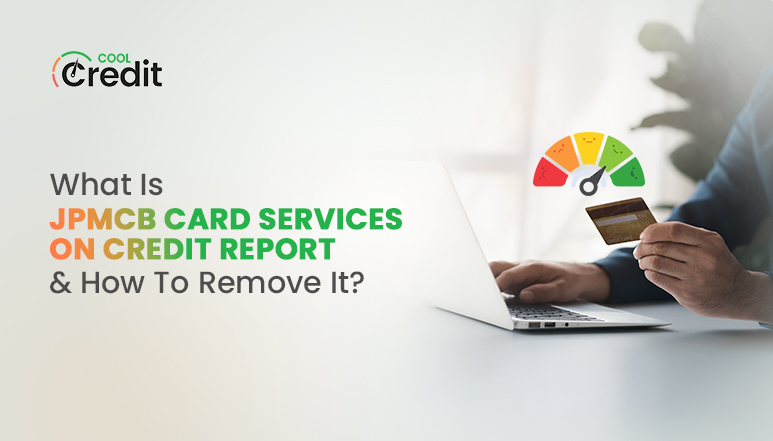
What Is JPMCB Card Services On Credit Report & How To Remove It?
Key Takeaway
“JPMCB Card Services” on your credit report indicates Chase credit card activity, such as an application, account, or authorized user status. If the entry is incorrect or unauthorized, you can dispute it with the credit bureaus, contact Chase directly, or use credit repair tools to have it removed and protect your score.
JPMCB Card Services showing up on your credit report can be puzzling. If you’ve ever spotted this mysterious entry and thought, “Wait, what even is that?”, you’re not alone. These kinds of cryptic entries can be perceived as financial red flags, especially when they appear without warning.
According to FICO, only 37% of U.S. consumers check their credit reports monthly. That means many people aren’t regularly monitoring their credit, so unexpected entries like JPMCB card services can come as a surprise, or even a worry.
Your Credit Deserves a Boost—Unlock AI Repair Tools Today.
Get StartedWhat Is JPMCB Card Services?
JPMCB stands for JPMorgan Chase Bank, one of the largest credit card issuers in the U.S. When you see “JPMCB card” or “JPMCB card services” listed on your report, it usually means there’s been some kind of interaction between you and Chase. That could be an active credit card account, a past application, or even just a soft inquiry.
The key takeaway? Understanding why JPMCB appears can help you prevent identity theft, monitor your credit health, and make informed financial decisions. In this post, we’ll break down what JPMCB card services means, and what to do if it wasn’t you who triggered the entry.
Common Reasons JPMCB Appears on Your Credit Report
Here are a few common reasons you might see JPMCB card services on your credit report:
- You have a Chase credit card — Active or closed, it’s still reported under the JPMCB name.
- You applied for a Chase card — Even if you didn’t get approved, the inquiry might be listed.
- You’re an authorized user — Someone else added you to their JPMCB card account.
- You were pre-screened — Chase may have done a soft pull to check your eligibility for one of their offers.
- You don’t recognize it — This could signal an error or, in rare cases, unauthorized activity.
Is JPMCB Card Services a Legitimate Entry?
JPMCB card services is a legitimate entry, especially if you’ve ever applied for, owned, or been added to a JPMCB card account. That said, still, if it looks unfamiliar, it’s smart to take a few minutes to double-check.
How to tell if it’s legit:
- Think back to any recent credit activity: Did you apply for a Chase credit card recently? Or get pre-approved for one? Those actions can leave a mark on your credit report, even if you didn’t go through with the application.
- Check if you were added as an authorized user: Someone in your household could’ve added you to their JPMCB card without you realizing it.
- Review the account details: Look at the account type, date opened, and recent activity. If the account is unfamiliar, take action.
- Check all three credit bureaus: Sometimes, entries only show up on one report (Experian, Equifax, or TransUnion), so compare all three to spot any inconsistencies.
Need to Be Sure? Contact JPMCB Directly
If you’ve gone through the steps above and it still doesn’t ring a bell, don’t stress; just reach out to Chase directly. A quick call can clear things up fast.
| JPMCB Customer Service Number: 1-800-945-2000 |
They can help you confirm if there’s an account tied to your name or if any credit checks were made on your behalf. If something’s wrong, they’ll walk you through what to do next.
What to Do If JPMCB Card Services Doesn’t Belong on Your Credit Report?
If you’ve found JPMCB card services on your credit report and are certain it doesn’t belong there, don’t panic; you have options. Whether it’s an outdated Chase account, an unauthorized inquiry, or a flat-out error, you can take steps to clean it up and protect your credit score.
Here’s a step-by-step guide to help you remove an incorrect or unwanted JPMCB entry:
1. Review Your Credit Reports Thoroughly
Start by pulling your full credit reports from all three major credit bureaus: Experian, Equifax, and TransUnion. Look for the entry labeled JPMCB card, JPMCB credit card, or JPMCB card services. Make note of:
▪ The date the account or inquiry appeared
▪ The type of entry (account, inquiry, or error)
▪ Any activity that doesn’t seem familiar
This gives you the full picture and ensures you're not missing anything across different bureaus.
2. Check with the company that pulled your credit
If you see that JPMorgan Chase pulled your credit report but don’t remember giving permission, reach out to the company that requested it. Ask them to confirm if you authorized the check. If they can’t prove you said yes, tell them to remove it from your report because unauthorized inquiries can lower your credit score.
3. Report any fraud to the FTC
If you suspect someone used your info without permission, report it to the Federal Trade Commission (FTC) right away. This helps protect you and starts the process of fixing any damage caused by identity theft.
4. Dispute Any Inaccurate or Unauthorized Information
If something looks wrong, like an account you never opened or a hard inquiry you didn’t authorize, it’s time to file a dispute. You can do this online or by mailing a written letter to the credit bureau(s) where the error appears.
Each bureau has its own process, but you’ll generally need to include:
▪ A copy of your report with the JPMCB entry highlighted
▪ A brief explanation of why it’s inaccurate
▪ Any supporting documentation (like proof of identity or account closure)
5. Use Credit Bureau Dispute Portals
Using credit bureau dispute portals is one of the fastest and most convenient ways to address errors on your credit report. Instead of mailing letters and waiting weeks for a response, you can submit your dispute directly through the official websites of the major credit bureaus - Experian, Equifax, and TransUnion.
6. Consider reaching out to a credit repair company
If you need help with the dispute process or aren’t sure what steps to take, a trusted credit repair service can guide you and handle it on your behalf.
Fix your Credit Report Errors-Download AI Credit Repair App Now
Start RepairHow to Prevent Unwanted JPMCB Entries in the Future
- Opt out of pre-approved credit offers to avoid soft inquiries from JPMCB and other issuers.
- Monitor your credit monthly using apps or services that alert you to new activity.
- Freeze your credit if you're not planning to apply for anything soon; this blocks unauthorized access.
- Be cautious when entering your details on financial websites; even checking your rate could trigger a soft pull from JPMCB card services.
Which Credit Cards Are Issued by JPMCB?
JPMCB also issues several co-branded and travel rewards cards, including:
- Amazon Prime Visa
- Southwest Rapid Rewards® Priority, Plus, and Premier Credit Cards
- United Cards: United Club℠, United℠ Explorer, United Gateway℠, and United Quest℠
- Marriott Bonvoy® Credit Cards: Boundless® and Bold®
- World of Hyatt Credit Card
These cards can appear on your credit report as JPMCB Card Services, which is simply the bank reporting activity to the bureaus.
Rebuilding Your Credit? Here’s the Smarter Way to Do It
Rebuilding your credit doesn't have to be overwhelming or time-consuming, especially when you have access to the right tools. Whether you're recovering from financial setbacks or simply trying to clean up your report, modern solutions like CoolCredit make the process smarter, faster, and less stressful.
Here’s how modern tools support your credit rebuilding journey:
▪ Spot inaccuracies fast: These tools scan your credit reports and flag entries that may be outdated, incorrect, or unauthorized.
▪ Automate disputes: They help you file disputes directly with the credit bureaus, generating letters and keeping track of responses, no paperwork or stress.
▪ Track all three bureaus: Stay on top of your Experian, Equifax, and TransUnion reports in one place, so nothing slips through the cracks.
▪ Real-time alerts: Get notified the moment something changes on your credit report, so if unexpected entries ever pop up again, you’ll know immediately.
Conclusion
Seeing “JPMCB Card Services” on your credit report might feel like a red flag at first, but, in most cases, it usually points to an interaction with JPMorgan Chase Bank, such as applying for a Chase credit card, being an authorized user, or having an active or closed account. That said, staying proactive is key. Regularly reviewing your credit reports helps you catch unfamiliar entries early, prevent fraud, and maintain a strong credit profile.
And if you want expert help removing errors or improving your credit the smart way, CoolCredit can simplify the process and guide you every step of the way.
FAQs
Q: Why Is JPMCB Reporting on My Credit File?
A: JPMCB stands for JPMorgan Chase Bank, and if you’re seeing it pop up on your credit report, it means you’ve had some sort of interaction with a Chase credit card, whether you remember it or not.
Perhaps you recently applied for a Chase credit card or were pre-screened for an offer, which can result in a soft inquiry. You might have even been added as an authorized user on someone else’s Chase card without realizing it.
It could also be linked to a current or past Chase account; even closed or inactive ones can remain on your report for some time, depending on how long ago the activity occurred. In short, JPMCB showing up doesn’t always mean there’s a problem, but it’s worth checking out if it caught you off guard.
Q: Can JPMCB Affect My Credit Score?
A: Yes, JPMCB entries can impact your credit score either positively or negatively, depending on the type of activity.
- A hard inquiry from a credit card application may cause a small, temporary dip in your score.
- Getting a new JPMCB credit card can affect your credit utilization, average account age, and payment history, which are all key factors in your credit score.
- A history of on-time payments on a JPMCB card can help boost your score, while late or missed payments can hurt it.
Q: How Long Does JPMCB Stay on a Credit Report?
A: It depends on the type of entry:
- Hard inquiries from a Chase card application remain on your credit report for up to two years.
- Closed or active JPMCB credit card accounts in good standing may remain on your report for up to 10 years after closure.
- Negative marks like missed payments or charge-offs stay on your report for up to 7 years.
Q: What Is a JPMCB Credit Card?
A: A JPMCB credit card is a credit card issued by JPMorgan Chase Bank (abbreviated as JPMCB). Chase offers a wide range of consumer and business credit cards under this umbrella, including popular ones like the Chase Sapphire Preferred, Freedom Unlimited, and Ink Business cards. On your credit report, any of these may appear as JPMCB or JPMCB card services.







